React with TypeScript 1st

2woongjae@gmail.com

React Fundamentals

2woongjae@gmail.com

React
React Component - 작업의 단위

Component Tree => DOM Tree
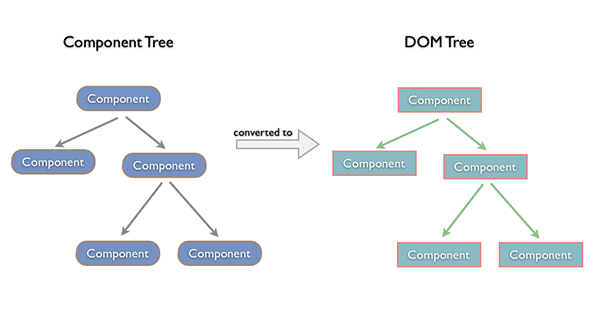
Virtual DOM - diff 로 변경
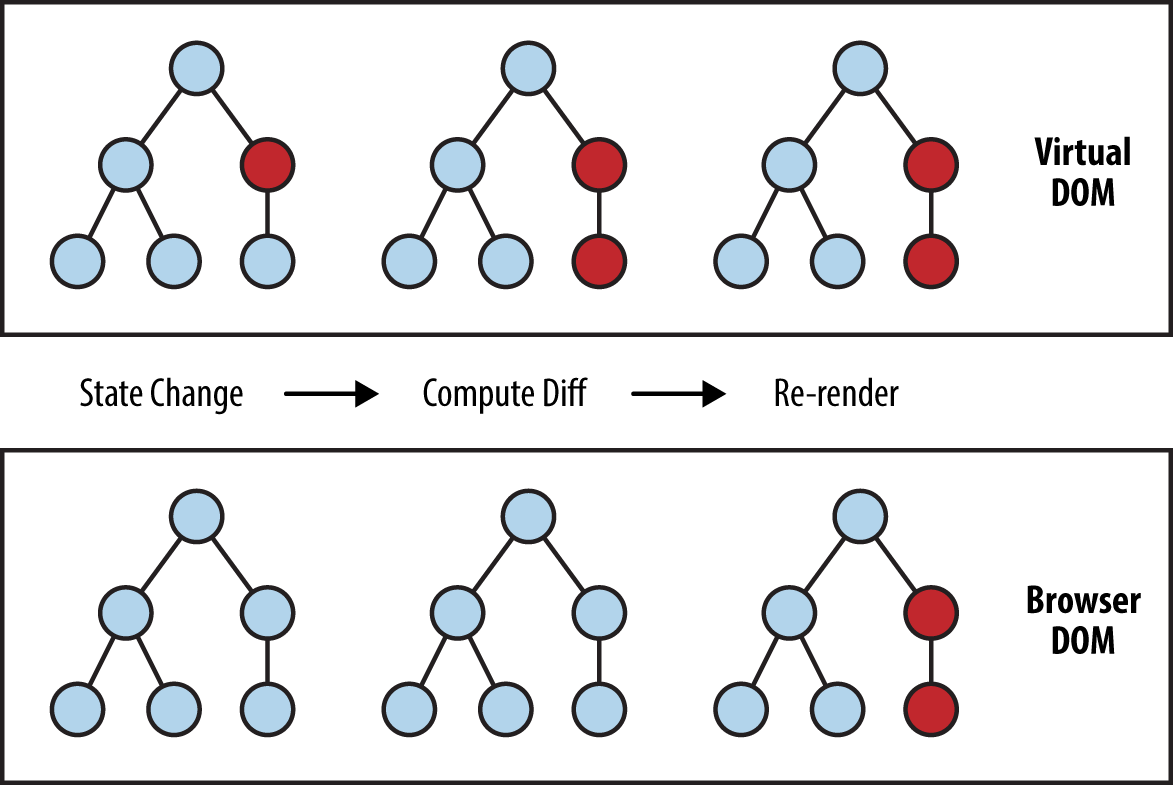
JSX
- JavaScript XML - JSX 자체는 문법
- 리액트에서는 JSX.Element 로 그려질 컴포넌트를 표현합니다.
- React.createElement 함수를 통해서도 JSX.Element 를 만들수 있습니다.
class HelloMessage extends React.Component {
render() {
return <div>Hello {this.props.name}</div>;
}
}
ReactDOM.render(<HelloMessage name="Jane" />, mountNode);class HelloMessage extends React.Component {
render() {
return React.createElement(
"div",
null,
"Hello ",
this.props.name
);
}
}
ReactDOM.render(React.createElement(HelloMessage, { name: "Jane" }), mountNode);React.Component - render
- return JSX.Element
- 리액트가 그려줍니다.
- 데이터(props, state)가 변하면, 다시 render 를 호출해서 그려줍니다.
- render 가 호출되고, 재호출되는 지점을 파악해야 합니다.
- render 를 JSX 로 표현해야합니다.
- 데이터와 JSX 가 합쳐져 하나의 컴포넌트를 이룹니다.
React 프로젝트 설정
React with Babel [ es6, jsx ]
- module bundler
- webpack 2
- webpack-dev-server
-
loader
-
babel-loader
- babel-core
- babel-preset-env
- babel-plugin-transform-react-jsx
-
babel-loader
- react
- react
- react-dom
React with Babel [ es6, jsx ]
{
"name": "start-project-babel",
"version": "1.0.0",
"main": "index.js",
"license": "MIT",
"devDependencies": {
"babel-core": "^6.25.0",
"babel-loader": "^7.0.0",
"babel-plugin-transform-react-jsx": "^6.24.1",
"babel-preset-env": "^1.5.2",
"react": "^15.6.1",
"react-dom": "^15.6.1",
"webpack": "^2.6.1",
"webpack-dev-server": "^2.4.5"
}
}React with TypeScript [ ts, tsx ]
- module bundler
- webpack 2
- webpack-dev-server
-
loader
-
ts-loader
- typescript
-
tslint-loader
- tslint
- tslint-react
- source-map-loader
-
ts-loader
- react
- react, @types/react
- react-dom, @types/react-dom
React with TypeScript [ ts, tsx ]
{
"name": "start-project-nocra",
"version": "1.0.0",
"main": "index.js",
"license": "MIT",
"devDependencies": {
"@types/react": "^15.0.29",
"@types/react-dom": "^15.5.0",
"react": "^15.6.1",
"react-dom": "^15.6.1",
"ts-loader": "^2.1.0",
"typescript": "^2.3.4",
"webpack": "^2.6.1",
"webpack-dev-server": "^2.4.5"
}
}
webpack.config.js
const path = require('path');
module.exports = {
// input 설정
entry: './src/index.tsx',
// output 설정
output: {
path: path.join(__dirname, 'dist'),
filename: 'bundle.js'
},
//
resolve: {
extensions: [".ts", ".tsx", ".js", ".jsx", ".json"]
},
// transformations 설정
module: {
rules: [
{
test: /\.(ts|tsx)$/,
loader: "ts-loader",
},
{
enforce: "pre",
test: /\.(ts|tsx)$/,
loader: "tslint-loader"
},
{
enforce: "pre",
test: /\.js$/,
loader: "source-map-loader"
}
]
},
// sourcemaps 설정 : Enable sourcemaps for debugging webpack's output.
devtool: 'source-map',
// server 설정
devServer: {
contentBase: path.join(__dirname, 'src'),
compress: true,
historyApiFallback: true
}
};tsconfig.json
{
"compilerOptions": {
"outDir": "dist",
"sourceMap": true,
"noImplicitAny": true,
"module": "commonjs",
"moduleResolution": "node",
"target": "es5",
"lib": ["es6", "dom"],
"jsx": "react"
},
"include": [
"./src/**/*"
]
}tslint-loader
Marks:start-project-nocra mark$ yarn add tslint, tslint-loader, tslint-react -Dtslint.json
{
"extends": ["tslint-react"],
"rules": {
"no-console": [
true,
"log",
"error",
"debug",
"info",
"time",
"timeEnd",
"trace"
]
}
}
React 프로젝트 with CRA
Creact React App by Dan Abramov
Create React App
- 리액트 프로그래밍 이외의 설정은 이제 그만
- 프로젝트 생성
- create-react-app <프로젝트명>
- 개발용 서버 실행
- npm run start
- 프로덕션 빌드
- npm run build
- 테스트
- npm run test
- 프로젝트 cra 에서 꺼내기 (?)
- npm run eject
- 프로젝트 생성
- pwa 적용
create-react-app start-project-cra --scripts-version=react-scripts-ts
start
test
build
eject
디렉토리 구조
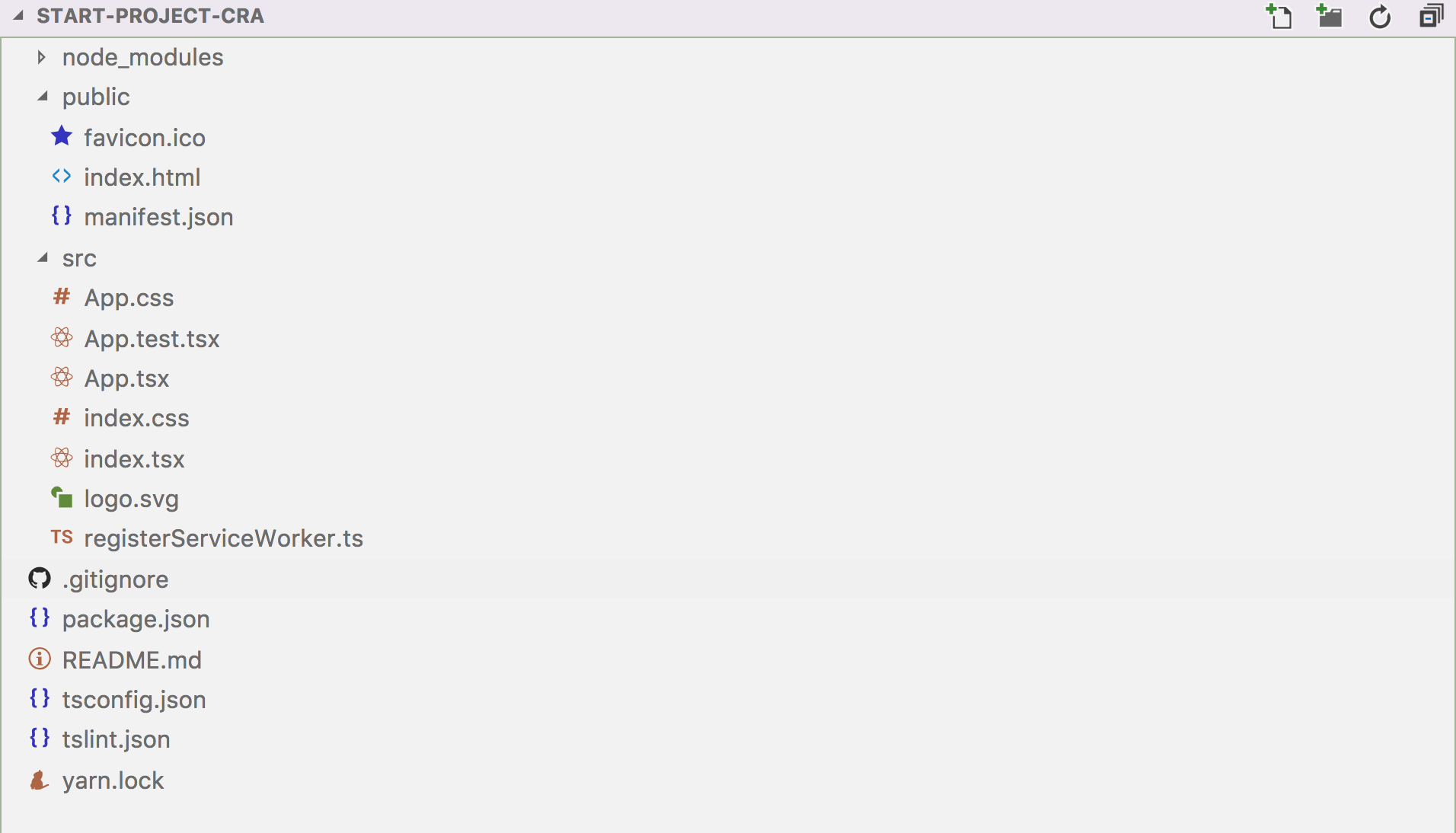
package.json
{
"name": "start-project-cra",
"version": "0.1.0",
"private": true,
"dependencies": {
"@types/jest": "^20.0.1",
"@types/node": "^8.0.1",
"@types/react": "^15.0.30",
"@types/react-dom": "^15.5.0",
"react": "^15.6.1",
"react-dom": "^15.6.1"
},
"devDependencies": {
"react-scripts-ts": "2.2.0"
},
"scripts": {
"start": "react-scripts-ts start",
"build": "react-scripts-ts build",
"test": "react-scripts-ts test --env=jsdom",
"eject": "react-scripts-ts eject"
}
}ts-loader => tsconfig.json
{
"compilerOptions": {
"outDir": "build/dist", // 빌드 결과물 폴더
"module": "commonjs", // 빌드 결과의 모듈 방식은 commonjs
"target": "es5", // 빌드 결과물은 es5 방식으로
"lib": ["es6", "dom"], // 라이브러리는 es6 와 dom
"sourceMap": true, // .map.js 파일도 함께 생성
"allowJs": true, // JS 파일도 컴파일 대상
"jsx": "react", // jsx 구문 사용 가능
"moduleResolution": "node", // 모듈 해석 방식은 node 처럼
"rootDir": "src", // 컴파일할 대상들이 들어있는 폴더 (루트 폴더)
"forceConsistentCasingInFileNames": true, // https://github.com/TypeStrong/ts-loader/issues/89
"noImplicitReturns": true, // 제대로 리턴 다 안되면 에러
"noImplicitThis": true, // this 표현식에 암시적으로 any 로 추론되면
"noImplicitAny": true, // 암시적으로 선언되었는데 any 로 추론되면
"strictNullChecks": true, // null 이나 undefined 을 서브 타입으로 사용하지 못하게 함
"suppressImplicitAnyIndexErrors": true, // 인덱싱 시그니처가 없는 경우, 인덱스를 사용했을때 noImplicitAny 에 의해 에러가 뜨는 것을 방지
"noUnusedLocals": true // 사용 안하는 로컬 변수가 있으면 에러
},
"exclude": [
"node_modules",
"build",
"scripts",
"acceptance-tests",
"webpack",
"jest",
"src/setupTests.ts"
],
"types": [
"typePatches" // 자동으로 패치되기 때문에 이렇게 막아놓은 듯
]
}tslint-loader => tslint.json
{
"extends": ["tslint-react"],
"rules": {
"align": [
true,
"parameters",
"arguments",
"statements"
],
"ban": false,
"class-name": true,
"comment-format": [
true,
"check-space"
],
"curly": true,
"eofline": false,
"forin": true,
"indent": [ true, "spaces" ],
"interface-name": [true, "never-prefix"],
"jsdoc-format": true,
"jsx-no-lambda": false,
"jsx-no-multiline-js": false,
"label-position": true,
"max-line-length": [ true, 120 ],
"member-ordering": [
true,
"public-before-private",
"static-before-instance",
"variables-before-functions"
],
"no-any": true,
"no-arg": true,
"no-bitwise": true,
"no-console": [
true,
"log",
"error",
"debug",
"info",
"time",
"timeEnd",
"trace"
],
"no-consecutive-blank-lines": true,
"no-construct": true,
"no-debugger": true,
"no-duplicate-variable": true,
"no-empty": true,
"no-eval": true,
"no-shadowed-variable": true,
"no-string-literal": true,
"no-switch-case-fall-through": true,
"no-trailing-whitespace": false,
"no-unused-expression": true,
"no-use-before-declare": true,
"one-line": [
true,
"check-catch",
"check-else",
"check-open-brace",
"check-whitespace"
],
"quotemark": [true, "single", "jsx-double"],
"radix": true,
"semicolon": [true, "always"],
"switch-default": true,
"trailing-comma": false,
"triple-equals": [ true, "allow-null-check" ],
"typedef": [
true,
"parameter",
"property-declaration"
],
"typedef-whitespace": [
true,
{
"call-signature": "nospace",
"index-signature": "nospace",
"parameter": "nospace",
"property-declaration": "nospace",
"variable-declaration": "nospace"
}
],
"variable-name": [true, "ban-keywords", "check-format", "allow-leading-underscore", "allow-pascal-case"],
"whitespace": [
true,
"check-branch",
"check-decl",
"check-module",
"check-operator",
"check-separator",
"check-type",
"check-typecast"
]
}
}src 디렉토리에서 코딩을 시작
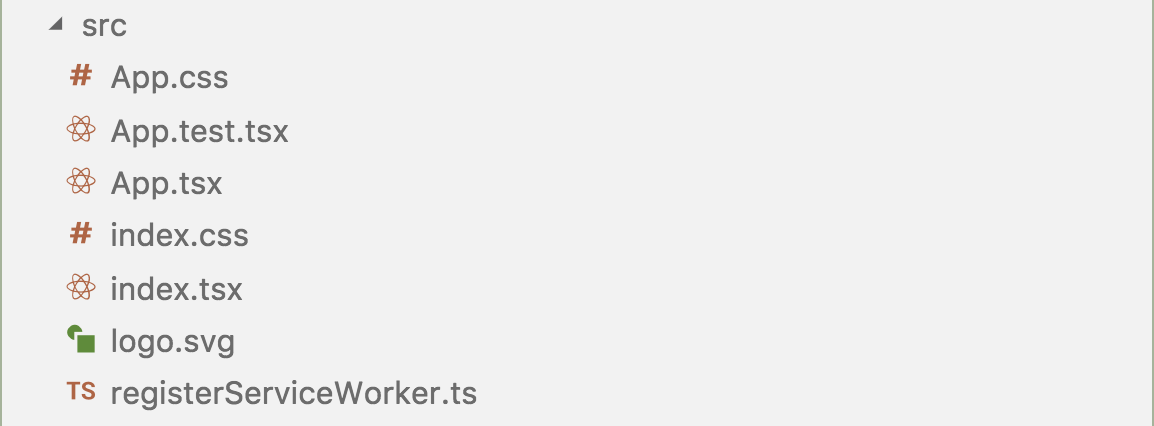
src 디렉토리
-
index.tsx
- 메인 엔트리 파일
- 꼭대기에서 ReactDom.render 를 수행
- pwa 를 위한 서비스 워커 등록 작업
-
index.css
- 글로벌 스타일 작성 => 프로그래밍 적으로 제한되지 않는다.
-
App.tsx
- App 컴포넌트 (샘플 컴포넌트)
- 클래스 이름과 파일 이름을 맞추는 것이 관례
-
App.css
- App 컴포넌트에서 쓰이는 스타일 => 일종의 암묵적 합의
-
App.test.tsx
- App 컴포넌트에 대한 테스트 작성 파일 => 3주차에 컴포넌트 테스트 시간에...
-
registerServiceWorker.ts
- pwa 서비스 워커 사용 등록 => 나중에 pwa 공부하면서...
index.tsx
import * as React from 'react';
import * as ReactDOM from 'react-dom';
import App from './App';
import registerServiceWorker from './registerServiceWorker';
import './index.css';
// react-dom 라이브러리를 이용해서 DOM 에 리액트 컴포넌트를 매칭
ReactDOM.render(
<App />,
document.getElementById('root') as HTMLElement
);
registerServiceWorker();App.tsx
import * as React from 'react';
import './App.css';
const logo = require('./logo.svg');
class App extends React.Component<{}, null> {
render() {
return (
<div className="App">
<div className="App-header">
<img src={logo} className="App-logo" alt="logo" />
<h2>Welcome to React</h2>
</div>
<p className="App-intro">
To get started, edit <code>src/App.tsx</code> and save to reload.
</p>
</div>
);
}
}
export default App;이제 Component 를 만들어 봅시다
React.Component<P, S> - Generic
class App extends React.Component<{}, null> {
render() {
return (
<h2>Hello World</h2>
);
}
}
class Component<P, S> {
constructor(props?: P, context?: any);
setState<K extends keyof S>(f: (prevState: S, props: P) => Pick<S, K>, callback?: () => any): void;
setState<K extends keyof S>(state: Pick<S, K>, callback?: () => any): void;
forceUpdate(callBack?: () => any): void;
render(): JSX.Element | null | false;
// React.Props<T> is now deprecated, which means that the `children`
// property is not available on `P` by default, even though you can
// always pass children as variadic arguments to `createElement`.
// In the future, if we can define its call signature conditionally
// on the existence of `children` in `P`, then we should remove this.
props: Readonly<{ children?: ReactNode }> & Readonly<P>;
state: Readonly<S>;
context: any;
refs: {
[key: string]: ReactInstance
};
}props, state
props, state
- props
- 컴포넌트 외부에서 컴포넌트로 넣어주는 데이터 (함수도 가능)
- 컴포넌트 내부에서는 자신의 props 를 변경할수 없다.
- 물론 돌아가면 가능은 하다.
- 컴포넌트 외부에서 props 데이터를 변경하면, render 가 다시 호출된다.
- state
- 컴포넌트 내부의 데이터
- 클래스의 프로퍼티와는 다르다.
- 프로퍼티는 변경한다고 render 가 호출되지 않는다는 점
- 생성자 혹은 프로퍼티 초기 할당으로 state 를 초기 할당 해줘야 한다.
- 내부에서 변경을 하더라도 setState 함수를 이용해야 render 가 호출된다.
props
class App extends React.Component<{ name: string }, null> {
render() {
return (
<h2>Hello {this.props.name}</h2>
);
}
}
ReactDOM.render(
<App name="Mark" />,
document.getElementById('root') as HTMLElement
);
class Component<P, S> {
constructor(props?: P, context?: any);
setState<K extends keyof S>(f: (prevState: S, props: P) => Pick<S, K>, callback?: () => any): void;
setState<K extends keyof S>(state: Pick<S, K>, callback?: () => any): void;
forceUpdate(callBack?: () => any): void;
render(): JSX.Element | null | false;
// React.Props<T> is now deprecated, which means that the `children`
// property is not available on `P` by default, even though you can
// always pass children as variadic arguments to `createElement`.
// In the future, if we can define its call signature conditionally
// on the existence of `children` in `P`, then we should remove this.
props: Readonly<{ children?: ReactNode }> & Readonly<P>;
state: Readonly<S>;
context: any;
refs: {
[key: string]: ReactInstance
};
}state 초기 할당 (X) - 사용을 안하면 문제 없다.
class App extends React.Component<{ name: string; }, { age: number; }> {
render() {
return (
// <h2>{this.props.name}</h2>
<h2>{this.props.name} - {this.state.age}</h2>
);
}
}
state 초기 할당
class App extends React.Component<{ name: string; }, { age: number; }> {
public state = {
age: 35
};
render() {
return (
<h2>Hello {this.props.name} - {this.state.age}</h2>
);
}
}
class App extends React.Component<{ name: string; }, { age: number; }> {
constructor(props: { name: string; }) {
super(props);
this.state = {
age: 35
};
}
render() {
return (
<h2>Hello {this.props.name} - {this.state.age}</h2>
);
}
}
class Component<P, S> {
constructor(props?: P, context?: any);
setState<K extends keyof S>(f: (prevState: S, props: P) => Pick<S, K>, callback?: () => any): void;
setState<K extends keyof S>(state: Pick<S, K>, callback?: () => any): void;
forceUpdate(callBack?: () => any): void;
render(): JSX.Element | null | false;
// React.Props<T> is now deprecated, which means that the `children`
// property is not available on `P` by default, even though you can
// always pass children as variadic arguments to `createElement`.
// In the future, if we can define its call signature conditionally
// on the existence of `children` in `P`, then we should remove this.
props: Readonly<{ children?: ReactNode }> & Readonly<P>;
state: Readonly<S>;
context: any;
refs: {
[key: string]: ReactInstance
};
}setState
class App extends React.Component<{ name: string; }, { age: number; }> {
constructor(props: { name: string; }) {
super(props);
this.state = {
age: 35
};
setInterval(() => {
// this.state.age = this.state.age + 1;
this.setState({
age: this.state.age + 1
});
}, 1000);
}
render() {
return (
<h2>Hello {this.props.name} - {this.state.age}</h2>
);
}
}
class Component<P, S> {
constructor(props?: P, context?: any);
setState<K extends keyof S>(f: (prevState: S, props: P) => Pick<S, K>, callback?: () => any): void;
setState<K extends keyof S>(state: Pick<S, K>, callback?: () => any): void;
forceUpdate(callBack?: () => any): void;
render(): JSX.Element | null | false;
// React.Props<T> is now deprecated, which means that the `children`
// property is not available on `P` by default, even though you can
// always pass children as variadic arguments to `createElement`.
// In the future, if we can define its call signature conditionally
// on the existence of `children` in `P`, then we should remove this.
props: Readonly<{ children?: ReactNode }> & Readonly<P>;
state: Readonly<S>;
context: any;
refs: {
[key: string]: ReactInstance
};
}interface
export interface AppProps {
name: string;
}
interface AppState {
age: number;
}
class App extends React.Component<AppProps, AppState> {
constructor(props: AppProps) {
super(props);
this.state = {
age: 35
};
setInterval(() => {
this.setState({
age: this.state.age + 1
});
}, 1000);
}
render() {
return (
<h2>Hello {this.props.name} - {this.state.age}</h2>
);
}
}Stateless Component
const StatelessComponent = (props: AppProps) => {
return (
<h2>{props.name}</h2>
);
}
const StatelessComponent: React.SFC<AppProps> = (props) => {
return (
<h2>{props.name}</h2>
);
}
type SFC<P> = StatelessComponent<P>;
interface StatelessComponent<P> {
(props: P & { children?: ReactNode }, context?: any): ReactElement<any>;
propTypes?: ValidationMap<P>;
contextTypes?: ValidationMap<any>;
defaultProps?: Partial<P>;
displayName?: string;
}P & {children?: ReactNode}
render() {
return (
<div>
<h2>Hello {this.props.name} - {this.state.age}</h2>
<StatelessComponent name="Anna" />
<StatelessComponent name="Anna">여기는 칠드런입니다. 있을수도 있고 없을 수도 있고</StatelessComponent>
</div>
);
}
const StatelessComponent: React.SFC<AppProps> = (props) => {
return (
<h2>{props.name}, {props.children}</h2>
);
}
type SFC<P> = StatelessComponent<P>;
interface StatelessComponent<P> {
(props: P & { children?: ReactNode }, context?: any): ReactElement<any>;
propTypes?: ValidationMap<P>;
contextTypes?: ValidationMap<any>;
defaultProps?: Partial<P>;
displayName?: string;
}
Lifecycle
Component 생성 및 마운트
import * as React from 'react';
import './App.css';
export interface AppProps {
name: string;
}
export interface AppState {
age: number;
}
class App extends React.Component<AppProps, AppState> {
private _interval: number;
constructor(props: AppProps) {
console.log('App constructor');
super(props);
this.state = {
age: 35
};
}
componentWillMount() {
console.log('App componentWillMount');
}
componentDidMount() {
console.log('App componentDidMount');
this._interval = window.setInterval(
() => {
this.setState({
age: this.state.age + 1
});
},
1000
);
}
componentWillUnmount() {
console.log('App componentWillUnmount');
clearInterval(this._interval);
}
render() {
console.log('App render');
return (
<div>
<h2>Hello {this.props.name} - {this.state.age}</h2>
</div>
);
}
}
export default App;
Component 생성 및 마운트
import * as React from 'react';
import './App.css';
export interface AppProps {
name: string;
}
export interface AppState {
age: number;
}
class App extends React.Component<AppProps, AppState> {
private _interval: number;
constructor(props: AppProps) {
console.log('App constructor');
super(props);
this.state = {
age: 35
};
}
componentWillMount() {
console.log('App componentWillMount');
}
componentDidMount() {
console.log('App componentDidMount');
this._interval = window.setInterval(
() => {
this.setState({
age: this.state.age + 1
});
},
1000
);
}
componentWillUnmount() {
console.log('App componentWillUnmount');
clearInterval(this._interval);
}
render() {
console.log('App render');
return (
<div>
<h2>Hello {this.props.name} - {this.state.age}</h2>
</div>
);
}
}
export default App;

constructor
componentWillMount
render
componentDidMount
Component props, state 변경
componentWillReceiveProps(nextProps: AppProps) {
console.log(`App componentWillReceiveProps : ${JSON.stringify(nextProps)}`);
}
shouldComponentUpdate(nextProps: AppProps, nextState: AppState): boolean {
console.log(`App shouldComponentUpdate : ${JSON.stringify(nextProps)}, ${JSON.stringify(nextState)}`);
return true;
}
componentWillUpdate(nextProps: AppProps, nextState: AppState) {
console.log(`App componentWillUpdate : ${JSON.stringify(nextProps)}, ${JSON.stringify(nextState)}`);
}
componentDidUpdate(prevProps: AppProps, prevState: AppState) {
console.log(`App componentDidUpdate : ${JSON.stringify(prevProps)}, ${JSON.stringify(prevState)}`);
}componentWillReceiveProps
shouldComponentUpdate
componentWillUpdate
render
componentDidUpdate

componentWillReceiveProps
- props 를 새로 지정했을 때 바로 호출됩니다.
- 여기는 state 의 변경에 반응하지 않습니다.
- 여기서 props 의 값에 따라 state 를 변경해야 한다면,
- setState 를 이용해 state 를 변경합니다.
- 그러면 다음 이벤트로 각각 가는것이 아니라 한번에 변경됩니다.
- 여기서 props 의 값에 따라 state 를 변경해야 한다면,
shouldComponentUpdate
- props 만 변경되어도
- state 만 변경되어도
- props & state 둘다 변경되어도
- newProps 와 new State 를 인자로 해서 호출
- return type 이 boolean 입니다.
- true 면 render
- false 면 render 가 호출되지 않습니다.
- 이 함수를 구현하지 않으면, 디폴트는 true
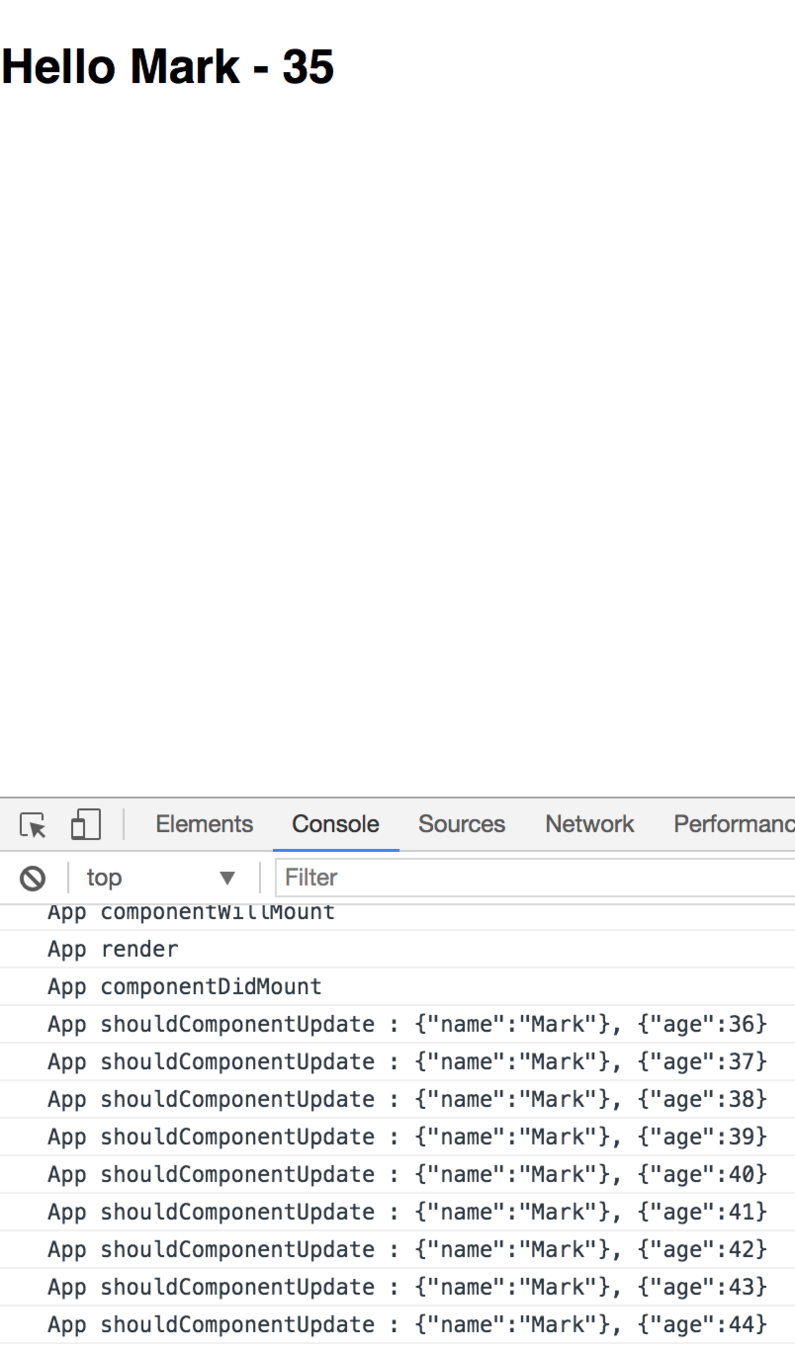
componentWillUpdate
- 컴포넌트가 재 랜더링 되기 직전에 불립니다.
- 여기선 setState 같은 것을 쓰면 아니됩니다.
componentDidUpdate
- 컴포넌트가 재 랜더링을 마치면 불립니다.

Event
DOM onclick => JSX onClick
constructor(props: AppProps) {
console.log('App constructor');
super(props);
this.state = {
age: 35
};
this._reset = this._reset.bind(this);
}
render() {
console.log('App render');
return (
<div>
<h2>Hello {this.props.name} - {this.state.age}</h2>
<button onClick={this._reset}>리셋</button>
</div>
);
}
private _reset(): void {
this.setState({
age: 35
});
}DOM onchange => JSX onChang
import * as React from 'react';
import './App.css';
export interface AppProps {
name: string;
}
export interface AppState {
age: number;
company: string;
}
class App extends React.Component<AppProps, AppState> {
private _interval: number;
constructor(props: AppProps) {
console.log('App constructor');
super(props);
this.state = {
age: 35,
company: 'Studio XID'
};
this._reset = this._reset.bind(this);
this._change = this._change.bind(this);
}
componentWillMount() {
console.log('App componentWillMount');
}
componentDidMount() {
console.log('App componentDidMount');
this._interval = window.setInterval(
() => {
this.setState({
age: this.state.age + 1
});
},
1000
);
}
componentWillUnmount() {
console.log('App componentWillUnmount');
clearInterval(this._interval);
}
componentWillReceiveProps(nextProps: AppProps) {
console.log(`App componentWillReceiveProps : ${JSON.stringify(nextProps)}`);
}
shouldComponentUpdate(nextProps: AppProps, nextState: AppState): boolean {
console.log(`App shouldComponentUpdate : ${JSON.stringify(nextProps)}, ${JSON.stringify(nextState)}`);
return true;
}
componentWillUpdate(nextProps: AppProps, nextState: AppState) {
console.log(`App componentWillUpdate : ${JSON.stringify(nextProps)}, ${JSON.stringify(nextState)}`);
}
componentDidUpdate(prevProps: AppProps, prevState: AppState) {
console.log(`App componentDidUpdate : ${JSON.stringify(prevProps)}, ${JSON.stringify(prevState)}`);
}
render() {
console.log('App render');
return (
<div>
<h2>Hello {this.props.name} - {this.state.age}</h2>
<button onClick={this._reset}>리셋</button>
<input type="text" onChange={this._change} value={this.state.company} />
</div>
);
}
private _reset(): void {
this.setState({
age: 35
});
}
private _change(e: React.ChangeEvent<HTMLInputElement>): void {
this.setState({
company: e.target.value
});
}
}
export default App;
Bye PropTypes
PropTypes
- React.PropTypes 를 더이상 함께 제공해 주지 않습니다.
- 별도의 라이브러리로 분리하였습니다.
- 사용자에게 선택의 폭을 준것이라 생각합니다.
- 선택
- 라이브러리로 제공되는 PropTypes
- https://www.npmjs.com/package/prop-types
- Facebook 에서 제공하는 Flow
- https://flow.org/
-
TypeScript 만세
- https://www.typescriptlang.org
- 라이브러리로 제공되는 PropTypes
- Flow 와 TypeScript 의 실사용 비교를 해보세요
- 전 그냥 타입스크립트 쓸게용
defaultProps
defaultProps 사용법 - class
// 사용시에 name props 를 쓰지 않으면,
ReactDOM.render(
<App />,
document.getElementById('root') as HTMLElement
);
// 이렇게 name 을 물음표를 이용해 옵셔널하게 처리
export interface AppProps {
name?: string;
}
// 클래스 안에 static 메서드를 이용해서 디폴트 값을 작성한다.
public static defaultProps = {
name: 'Default'
};
// type definition 에 따르면 Props 의 부분집합이다.
defaultProps?: Partial<P>;defaultProps 사용법 - function
export interface AppProps {
name?: string;
}
const StatelessComponent: React.SFC<AppProps> = (props) => {
return (
<h2>{props.name}</h2>
);
}
StatelessComponent.defaultProps = {
name: 'Default'
};defaultProps 사용법 - function 2
export interface AppProps {
name?: string;
}
const StatelessComponent: React.SFC<AppProps> = ({name = 'Default'}) => {
return (
<h2>{props.name}</h2>
);
}하위 컴포넌트를 변경하기
button 를 클릭하여 Grand Child 를 변경하려면
- Grand Parent
- Parent
- Me
- Child
- Grand Chid
- Child
- Me
- <button></button>
- Parent
- 1. Grand Parent 컴포넌트에서 button 에 onClick 이벤트를 만들고,
- 2. 클릭하면, Grand Parent 의 state 를 변경하여, Parent1 로 내려주는 Props 를 변경
- 3. Parent1 의 Props 가 변경되면, Me 의 props 에 전달
- 4. Me 의 Props 가 변경되면, Child 의 props 로 전달
- 5. Child 의 Props 가 변경되면 Grand Child 의 props 로 전달
import * as React from 'react';
import './App.css';
export interface AppProps {
}
export interface AppState {
toGrandChild: string;
}
class App extends React.Component<AppProps, AppState> {
constructor(props: AppProps) {
console.log('App constructor');
super(props);
this.state = {
toGrandChild: '아직 안바뀜'
};
this._clickToGrandChild = this._clickToGrandChild.bind(this);
}
componentWillMount() {
console.log('App componentWillMount');
}
componentDidMount() {
console.log('App componentDidMount');
}
componentWillUnmount() {
console.log('App componentWillUnmount');
}
componentWillReceiveProps(nextProps: AppProps) {
console.log(`App componentWillReceiveProps : ${JSON.stringify(nextProps)}`);
}
shouldComponentUpdate(nextProps: AppProps, nextState: AppState): boolean {
console.log(`App shouldComponentUpdate : ${JSON.stringify(nextProps)}, ${JSON.stringify(nextState)}`);
return true;
}
componentWillUpdate(nextProps: AppProps, nextState: AppState) {
console.log(`App componentWillUpdate : ${JSON.stringify(nextProps)}, ${JSON.stringify(nextState)}`);
}
componentDidUpdate(prevProps: AppProps, prevState: AppState) {
console.log(`App componentDidUpdate : ${JSON.stringify(prevProps)}, ${JSON.stringify(prevState)}`);
}
render() {
console.log('App render');
return (
<div>
<Parent {...this.state} />
<button onClick={this._clickToGrandChild}>GrandChild 의 값을 바꾸기</button>
</div>
);
}
private _clickToGrandChild(): void {
this.setState({
toGrandChild: '그랜드 차일드의 값을 변경'
});
}
}
interface ParentProp {
toGrandChild: string;
}
const Parent: React.SFC<ParentProp> = (props) => {
return (
<div>
<p>여긴 Parent</p>
<Me {...props} />
</div>
);
};
interface MeProp {
toGrandChild: string;
}
const Me: React.SFC<MeProp> = (props) => {
return (
<div>
<p>여긴 Me</p>
<Child {...props} />
</div>
);
};
interface ChildProp {
toGrandChild: string;
}
const Child: React.SFC<ChildProp> = (props) => {
return (
<div>
<p>여긴 Child</p>
<GrandChild {...props} />
</div>
);
};
interface GrandChildProp {
toGrandChild: string;
}
const GrandChild: React.SFC<GrandChildProp> = (props) => {
return (
<div>
<p>여긴 GrandChild</p>
<h3>{props.toGrandChild}</h3>
</div>
);
};
export default App;button 를 클릭하여 Grand Child 를 변경하려면
상위 컴포넌트를 변경하기
Grand Child 를 클릭하여 p 의 내용을 변경하려면
- Grand Parent
- Parent
- Me
- Child
- Grand Chid
- Child
- Me
- <p></p>
- Parent
- 1. Grand Parent 에서 함수를 만들고, 그 함수 안에 state 를 변경하도록 구현, 그 변경으로 인해 p 안의 내용을 변경.
- 2. 만들어진 함수를 props 에 넣어서, parent1 로 전달
- 3. Parent1 의 props 의 함수를 Me 의 props 로 전달
- 4. Me 의 Props 의 함수를 Child 의 props 로 전달
- 5. Child 의 Props 의 함수를 Grand Child 의 props 로 전달
import * as React from 'react';
import './App.css';
export interface AppProps {
}
export interface AppState {
fromGrandChild: string;
}
class App extends React.Component<AppProps, AppState> {
constructor(props: AppProps) {
console.log('App constructor');
super(props);
this.state = {
fromGrandChild: '아직 안바뀜'
};
this._clickFromGrandChild = this._clickFromGrandChild.bind(this);
}
componentWillMount() {
console.log('App componentWillMount');
}
componentDidMount() {
console.log('App componentDidMount');
}
componentWillUnmount() {
console.log('App componentWillUnmount');
}
componentWillReceiveProps(nextProps: AppProps) {
console.log(`App componentWillReceiveProps : ${JSON.stringify(nextProps)}`);
}
shouldComponentUpdate(nextProps: AppProps, nextState: AppState): boolean {
console.log(`App shouldComponentUpdate : ${JSON.stringify(nextProps)}, ${JSON.stringify(nextState)}`);
return true;
}
componentWillUpdate(nextProps: AppProps, nextState: AppState) {
console.log(`App componentWillUpdate : ${JSON.stringify(nextProps)}, ${JSON.stringify(nextState)}`);
}
componentDidUpdate(prevProps: AppProps, prevState: AppState) {
console.log(`App componentDidUpdate : ${JSON.stringify(prevProps)}, ${JSON.stringify(prevState)}`);
}
render() {
console.log('App render');
return (
<div>
<Parent clickFromGrandChild={this._clickFromGrandChild} />
<p>{this.state.fromGrandChild}</p>
</div>
);
}
private _clickFromGrandChild(): void {
this.setState({
fromGrandChild: '그랜드 차일드로 부터 값이 변경되었음.'
});
}
}
interface ParentProp {
clickFromGrandChild(): void;
}
const Parent: React.SFC<ParentProp> = (props) => {
return (
<div>
<p>여긴 Parent</p>
<Me {...props} />
</div>
);
};
interface MeProp {
clickFromGrandChild(): void;
}
const Me: React.SFC<MeProp> = (props) => {
return (
<div>
<p>여긴 Me</p>
<Child {...props} />
</div>
);
};
interface ChildProp {
clickFromGrandChild(): void;
}
const Child: React.SFC<ChildProp> = (props) => {
return (
<div>
<p>여긴 Child</p>
<GrandChild {...props} />
</div>
);
};
interface GrandChildProp {
clickFromGrandChild(): void;
}
const GrandChild: React.SFC<GrandChildProp> = (props) => {
return (
<div>
<p>여긴 GrandChild</p>
<button onClick={props.clickFromGrandChild}>GrandChild 버튼</button>
</div>
);
};
export default App;Grand Child 를 클릭하여 p 의 내용을 변경하려면
Composition
"Facebook 은 수천개의 컴포넌트에서 React 를 사용하며, 컴포넌트 상속 계층을 사용하는 것이 권장되는 use case 를 찾지 못했습니다."
"컴포넌트에서 UI 이외의 기능을 재사용 하고 싶으면,
상속을 이용하지 말고 자바스크립트 모듈로 분리해서 사용하는것이 좋다"
컴포지션의 기본은 props 의 활용
props 를 이용한 명시적이고 안전한 재사용
function SplitPane(props) {
return (
<div className="SplitPane">
<div className="SplitPane-left">
{props.left}
</div>
<div className="SplitPane-right">
{props.right}
</div>
</div>
);
}
function App() {
return (
<SplitPane
left={
<Contacts />
}
right={
<Chat />
} />
);
}Refs
자식의 무언가를 변경하려면, props ?
- props 를 다루지 않고 자식의 어떤 요소를 건들고 싶다면 ?
- ref 를 이용해서 랜더를 다시 하지 않고 하위 요소를 다룰 수 있다.
ref 를 props 로 끌어올리기
interface CustomTextInputProps {
inputRef(element: HTMLInputElement): void;
}
function CustomTextInput(props: CustomTextInputProps) {
return (
<div>
<input ref={props.inputRef} />
</div>
);
}
function Parent(props: ParentProps) {
return (
<div>
My input: <CustomTextInput inputRef={props.inputRef} />
</div>
);
}
interface ParentProps {
inputRef(element: HTMLInputElement): void;
}
class App extends React.Component<AppProps, AppState> {
inputElement: HTMLInputElement | null;
constructor(props: AppProps) {
console.log('App constructor');
super(props);
}
componentWillMount() {
console.log('App componentWillMount');
}
componentDidMount() {
console.log('App componentDidMount');
}
componentWillUnmount() {
console.log('App componentWillUnmount');
}
componentWillReceiveProps(nextProps: AppProps) {
console.log(`App componentWillReceiveProps : ${JSON.stringify(nextProps)}`);
}
shouldComponentUpdate(nextProps: AppProps, nextState: AppState): boolean {
console.log(`App shouldComponentUpdate : ${JSON.stringify(nextProps)}, ${JSON.stringify(nextState)}`);
return true;
}
componentWillUpdate(nextProps: AppProps, nextState: AppState) {
console.log(`App componentWillUpdate : ${JSON.stringify(nextProps)}, ${JSON.stringify(nextState)}`);
}
componentDidUpdate(prevProps: AppProps, prevState: AppState) {
console.log(`App componentDidUpdate : ${JSON.stringify(prevProps)}, ${JSON.stringify(prevState)}`);
}
render() {
console.log('App render');
return (
<div>
<Parent inputRef={element => this.inputElement = element} />
</div>
);
}
}
export default App;PureComponent
Component props, state 변경
componentWillReceiveProps(nextProps: AppProps) {
console.log(`App componentWillReceiveProps : ${JSON.stringify(nextProps)}`);
}
shouldComponentUpdate(nextProps: AppProps, nextState: AppState): boolean {
console.log(`App shouldComponentUpdate : ${JSON.stringify(nextProps)}, ${JSON.stringify(nextState)}`);
return true;
}
componentWillUpdate(nextProps: AppProps, nextState: AppState) {
console.log(`App componentWillUpdate : ${JSON.stringify(nextProps)}, ${JSON.stringify(nextState)}`);
}
componentDidUpdate(prevProps: AppProps, prevState: AppState) {
console.log(`App componentDidUpdate : ${JSON.stringify(prevProps)}, ${JSON.stringify(prevState)}`);
}componentWillReceiveProps
shouldComponentUpdate
componentWillUpdate
render
componentDidUpdate

shouldComponentUpdate
- 일반 컴포넌트는
- 따로 구현하지 않으면 props, state 가 바뀌면 무조건 render
- Pure 컴포넌트는
- shouldComponentUpdate 가 다른 방식으로 구현되어 있는 것이다.
- shallow compare
- nested object 값의 변경을 감지하지 못한다.
- immutable.js 를 사용하는 이유
- 모든 컴포넌트를 Pure 로 하는 것이 성능상 이점이 있는건 아니다.
PureComponent
import * as React from 'react';
import './App.css';
export interface AppProps {
}
export interface AppState {
todo: string[];
}
class App extends React.PureComponent<AppProps, AppState> {
constructor(props: AppProps) {
console.log('App constructor');
super(props);
this.state = {
todo: ['First']
};
this._addSecond = this._addSecond.bind(this);
}
componentWillMount() {
console.log('App componentWillMount');
}
componentDidMount() {
console.log('App componentDidMount');
}
componentWillUnmount() {
console.log('App componentWillUnmount');
}
componentWillReceiveProps(nextProps: AppProps) {
console.log(`App componentWillReceiveProps : ${JSON.stringify(nextProps)}`);
}
/*
shouldComponentUpdate(nextProps: AppProps, nextState: AppState): boolean {
console.log(`App shouldComponentUpdate : ${JSON.stringify(nextProps)}, ${JSON.stringify(nextState)}`);
return true;
}
*/
componentWillUpdate(nextProps: AppProps, nextState: AppState) {
console.log(`App componentWillUpdate : ${JSON.stringify(nextProps)}, ${JSON.stringify(nextState)}`);
}
componentDidUpdate(prevProps: AppProps, prevState: AppState) {
console.log(`App componentDidUpdate : ${JSON.stringify(prevProps)}, ${JSON.stringify(prevState)}`);
}
render() {
console.log('App render');
return (
<div>
<p>{this.state.todo.join(', ')}</p>
<button onClick={this._addSecond}>Second 추가</button>
</div>
);
}
private _addSecond(): void {
const todo: string[] = this.state.todo;
todo.push('Second');
this.setState({
todo: todo
});
}
}
export default App;